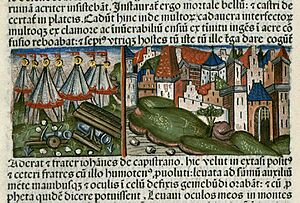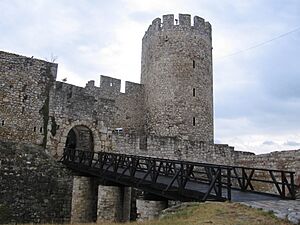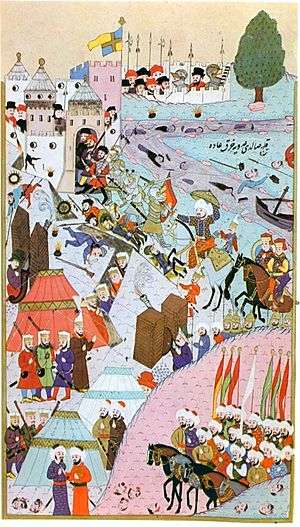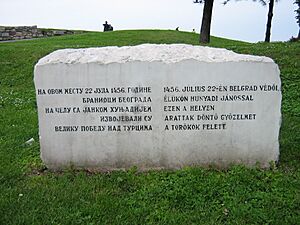Siege of Belgrade (1456) facts for kids
Quick facts for kids Siege of Belgrade (Nándorfehérvár) |
|||||||
|---|---|---|---|---|---|---|---|
| Part of the Ottoman wars in Europe Ottoman-Hungarian Wars |
|||||||
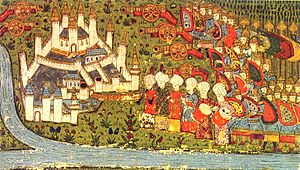 Ottoman miniature of the siege of Belgrade, 1456 |
|||||||
|
|||||||
| Belligerents | |||||||
| Kingdom of Hungary Serbian Despotate |
Ottoman Empire | ||||||
| Commanders and leaders | |||||||
|
Mehmed II (WIA) Zagan Pasha Mahmud Pasha Karaca Pasha † |
||||||
| Strength | |||||||
| 7,000 Castle defenders of Michael Szilágyi 10,000–12,000 Professional army of John Hunyadi (mostly cavalry) A motley army about 30,000–60,000 recruited Crusaders (with only some professional units) 200 boats (only 1 galley) 40 boats from the city Artillery |
30,000; 60,000; higher estimates of 100,000 200 vessels 300 cannons (22 giant one), 7 siege engines (2 mortars) |
||||||
| Casualties and losses | |||||||
| Unknown | 13,000 men 200 galleys 300 cannons |
||||||
The Siege of Belgrade (also known as the Siege of Nándorfehérvár) was a big battle that happened from July 4 to July 22, 1456. It took place after the fall of Constantinople in 1453. The Ottoman Empire, led by Sultan Mehmed II, wanted to expand into Europe. They tried to capture Belgrade, a very important city in Hungary at the time. Belgrade was key for controlling the Danube River and the Balkans.
The Hungarian defenders, led by John Hunyadi, fought bravely. Hunyadi had paid to make the city's fortress stronger. The siege lasted for several weeks, and both sides lost many soldiers. The defenders used new tactics, like heavy cannons and firearms, to fight off the Ottoman attacks. Hunyadi's army also destroyed an Ottoman fleet on July 14, 1456. Then, they defeated the Ottoman land forces outside Belgrade on July 21–22. Sultan Mehmed II was hurt and had to give up the siege and retreat on July 22, 1456.
This victory made European Christian forces feel much more hopeful. It was a major turning point because it stopped the Ottoman Empire from expanding further into Europe for a while. John Hunyadi became famous for defending Belgrade, but he sadly died of the plague a few weeks later. The Ottomans continued to expand in other areas, and the fight between the Ottoman Empire and European powers went on for centuries. This battle also showed how important firearms and cannons were becoming in warfare.
Contents
Why Belgrade Was Important
The Ottoman Empire, led by Sultan Mehmed II, had just captured Constantinople in 1453. This made Constantinople their new capital and ended the Byzantine Empire. The Ottomans then wanted to expand even more into Europe.
They saw Belgrade as a very important city. It was a strong fortress located where the Danube and Sava rivers meet. This made it a perfect gateway for them to move north into Europe. The Ottomans' plans to expand were a big threat to European countries. This led to a combined effort to stop them. In 1452, John Hunyadi became the captain general of Hungary.
Getting Ready for Battle
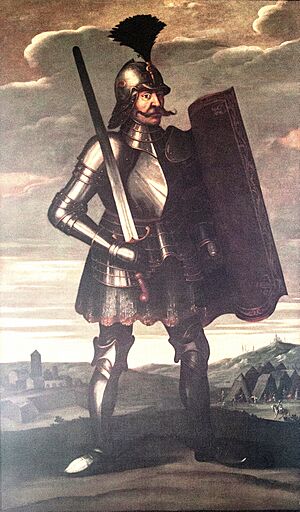
In late 1455, Hunyadi heard that the Ottomans were planning an attack. He started getting Belgrade ready for defense. He told the Pope's representative that he would pay for 7,000 men to fight the Ottomans. He also asked for more military help.
Hunyadi then put 5,000 hired soldiers in the Belgrade fortress. He placed them under the command of his brother-in-law, Michael Szilágyi, and his oldest son, Laszlo Hunyadi. People from Belgrade helped move the war machines. Hunyadi then gathered another army of 12,000 soldiers. In April 1456, a general call for everyone to join the army was made.
An Italian friar named Giovanni da Capistrano also helped. He was sent to Hungary to preach about a crusade against the Ottomans. He encouraged farmers and local landowners to join the defense of Europe. About 25,000 crusaders joined, but most were inexperienced farmers. Some only had clubs and slings. These new recruits joined Hunyadi's army, which also had skilled hired soldiers and some knights. In total, Hunyadi gathered about 25,000 to 30,000 men.
As the Ottoman army got closer to Belgrade, they passed through Sofia. On June 18, they met a Serbian army of about 9,000 soldiers. The smaller Serbian forces were completely defeated. By the end of June, the Ottomans were near Belgrade.
The Siege Begins
Setting Up the Armies
Before Hunyadi could bring all his forces together, Sultan Mehmed II's army arrived at Belgrade. This army had between 60,000 and 70,000 men. The siege started on July 4, 1456. The Ottomans immediately began firing cannons at the city walls.
Szilágyi had only about 5,000 to 7,000 men inside the castle. Mehmed set up his siege on the headland and started heavily bombarding the city's walls on June 29. He arranged his men in three parts:
- The Rumelian corps had most of his 300 cannons.
- His fleet of 200 river boats had the rest of the cannons.
- The Rumelians were on the right side, and the Anatolian corps were on the left.
- In the middle were the Sultan's personal guards, the Janissaries, and his command post. Both the Anatolian corps and the Janissaries were heavy infantry.
Mehmed placed his river boats mainly to the northwest of the city. Their job was to patrol the marshes and stop anyone from sending help to the fortress. They also watched the Sava river to the southwest. The area from the Danube eastward was guarded by the Sipahi, the Sultan's heavy cavalry. This was to prevent attacks from the right side.
When Hunyadi found out about this, he was in southern Hungary. He was gathering more light cavalry for his army to break the siege. Not many nobles helped, but the farmers were very eager to join. Capistrano, the friar, managed to gather a large army of farmers. They were not well-trained or equipped, but they marched towards Belgrade. Capistrano and Hunyadi traveled together, but they led their armies separately. Together, they had about 40,000 to 50,000 troops.
The defenders inside Belgrade were outnumbered. They relied on the strength of the amazing Belgrade castle. It was one of the best-designed castles in the Balkans at that time. The fortress was on a hill and had three lines of defense:
- The inner castle with the palace.
- A huge upper town with military camps, four gates, and a double wall.
- A lower town with a cathedral and a port on the Danube.
This fortress was a great example of medieval military building. It also had the natural protection of the rivers where the Danube and Sava meet. On July 2, Capistrano arrived at Belgrade.
River Battle
Hunyadi set up his camp near the Zemun fortress. The Ottoman fleet surrounded Belgrade on the Danube to stop supplies from reaching the city. Hunyadi's main goal was to open the river passage to help the besieged defenders. To do this, he gathered all the ships on the Danube. He also told Szilágyi to be ready to attack the Ottoman fleet from inside the city. Szilágyi prepared about forty boats, crewed by Serbians from Belgrade. The Ottoman fleet had 60 large galleys and about 150 smaller boats.
On July 14, 1456, a five-hour battle started on the river. Hunyadi broke the Ottoman naval blockade. He sank three large Ottoman galleys and captured four large vessels and 20 smaller ones. By destroying the Sultan's fleet, Hunyadi could bring his troops and much-needed food into the city. The fortress's defenses were also made stronger.
Ottoman Attack
After a week of heavy cannon fire, the fortress walls were broken in several places. On July 21, Mehmed ordered a full-scale attack. It began at sunset and continued all night. The attacking army poured into the city and then started to assault the fort. This was the most important moment of the siege. Hunyadi ordered the defenders to throw burning wood and other flammable materials. This created a wall of flames. This wall separated the Janissaries fighting in the city from their fellow soldiers trying to break through the gaps into the upper town.
The battle between the trapped Janissaries and Szilágyi's soldiers inside the upper town turned in favor of the Christians. The Hungarians managed to fight off the fierce attack from outside the walls. The Janissaries remaining inside the city were killed. The Ottoman troops trying to break into the upper town suffered heavy losses.
The Final Fight
The next day, some peasant crusaders started a spontaneous action. They forced Capistrano and Hunyadi to use the situation. Hunyadi had ordered the defenders not to try to loot the Ottoman positions. But some units crept out from the damaged walls. They took positions opposite the Ottoman line and started bothering the enemy soldiers. Ottoman Sipahis tried to scatter them but failed. Soon, more defenders joined those outside the wall. What started as a small incident quickly became a full battle.
John of Capistrano first tried to order his men back inside the walls. But soon he found himself surrounded by about 2,000 peasant fighters. He then began leading them toward the Ottoman lines, shouting, "The Lord who made the beginning will take care of the finish!" Capistrano led his crusaders to the Ottoman rear across the Sava river. At the same time, Hunyadi launched a desperate charge from the fort. He aimed to capture the cannon positions in the Ottoman camp.
The Ottomans were surprised by this strange turn of events. Some historians say they were paralyzed by an unexplained fear. They fled. The Sultan's bodyguard of about 5,000 Janissaries tried hard to stop the panic and recapture the camp. But by then, Hunyadi's army had also joined the unplanned battle. The Ottoman efforts became hopeless. The Sultan himself joined the fight and killed a knight. But then he was hit by an arrow in the thigh and lost consciousness. After the battle, the Hungarian raiders were told to spend the night behind the fortress walls. They were to be ready for a possible new attack, but the Ottoman counterattack never came.
Under the cover of darkness, the Ottomans retreated quickly. They carried their wounded in 140 wagons. They went back to Constantinople.
What Happened Next
The Hungarians paid a high price for this victory. A plague broke out in the camp. John Hunyadi himself died from it three weeks later in Zimony, Hungary (now Zemun, Serbia), on August 11, 1456. He was buried in the Cathedral of Gyulafehérvár (now Alba Iulia).
The fortress design proved very strong during the siege. So, the Hungarians added more reinforcements. The weaker eastern walls, where the Ottomans broke through, were strengthened. They added the Zindan Gate and the strong Nebojša Tower. These were the last major changes to the fortress until 1521. That's when Mehmed's great-grandson, Suleiman, finally captured it.
The Noon Bell
Pope Callixtus III ordered church bells across Europe to ring every day at noon. This was a call for people to pray for the city's defenders. The tradition of the noon bell is often linked to the victory at Belgrade and the Pope's order. In many countries, news of the victory arrived before the order. So, the ringing of church bells at noon became a way to remember the victory. The Pope never canceled the order. Catholic and older Protestant churches still ring the noon bell today.
The Pope had already asked all Catholic kingdoms to pray for Belgrade's defenders. After the victory, he celebrated by making a special day to remember it. This led to the story that the noon bell ritual, started by the Pope before the battle, was created to celebrate the victory. July 22, the day of the victory, has been a memorial day in Hungary ever since.
This custom is still followed by Protestant and Orthodox churches too. At the University of Oxford in England, the victory was celebrated with bells ringing and big parties. Hunyadi sent a special messenger, Erasmus Fullar, to Oxford with the news of the victory.
Lasting Impact
The victory at Belgrade stopped the Ottoman advance into Europe for 70 years. They did make other attacks, like taking Otranto (1480–1481) and raiding Croatia and Styria (1493). Belgrade continued to protect Hungary from Ottoman attacks until the fort fell to the Ottomans in 1521.
After the siege of Belgrade stopped Mehmed II from moving into Central Europe, Serbia and Bosnia became part of the Ottoman Empire. Wallachia, the Crimean Khanate, and later Moldavia became vassal states. This means they were under Ottoman control but kept some independence. This was because they put up strong military resistance. There were several reasons why the Sultan did not directly attack Hungary after his defeat at Belgrade. The loss at Belgrade showed that the Empire could not expand further until Serbia and Bosnia were fully under control. Also, the strong political and military power of Hungary under Matthias Corvinus in the region likely made him hesitate. Mehmed was also busy dealing with his Moldovan and Wallachian vassals who were rebelling.
With Hunyadi's victory at Belgrade, both Vlad III the Impaler and Stephen III of Moldavia became powerful leaders in their own lands. Hunyadi also worked hard to get his son Matthias placed on the Hungarian throne. Hunyadi's strong leadership and the fierce resistance ensured that Sultan Mehmed would only get as far as the Balkans in Europe. However, the Sultan had already made the Ottoman Empire one of the most feared powers in Europe and Asia for centuries. Most of Hungary was eventually conquered in 1526 at the Battle of Mohács. Ottoman Muslim expansion into Europe continued successfully until the siege of Vienna in 1529. Ottoman power in Europe remained strong and threatening to Central Europe until the Battle of Vienna in 1683.
Stories and Art
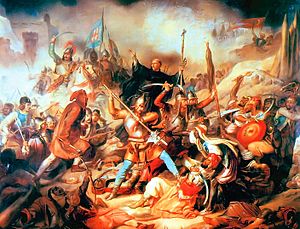
It is said that after the defeat, as Mehmed and his army retreated into Bulgaria, he was so angry that he wounded some of his generals with his own sword before having them executed. He had lost at least 24,000 of his best soldiers. The Sultan later fought with Stephen III of Moldavia. This led to an even worse defeat at the Battle of Vaslui and later a costly victory at the Battle of Valea Albă.
An English poet and playwright named Hannah Brand wrote a five-act play about the battle and siege of Belgrade. It was first performed in 1791. A fictional story from the view of a Christian mercenary is Christian Cameron's Tom Swan and the Siege of Belgrade (2014–2015).
|


